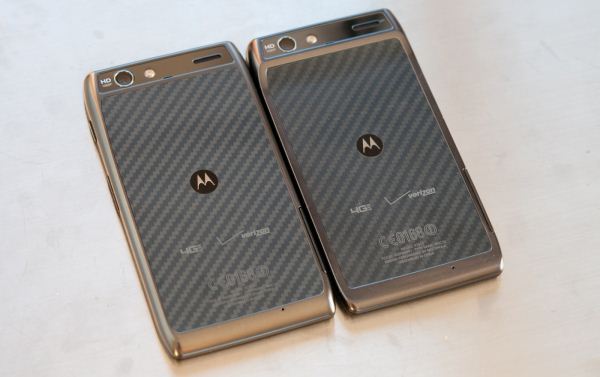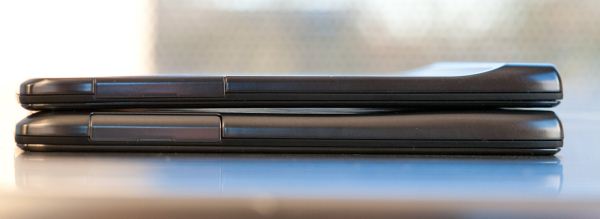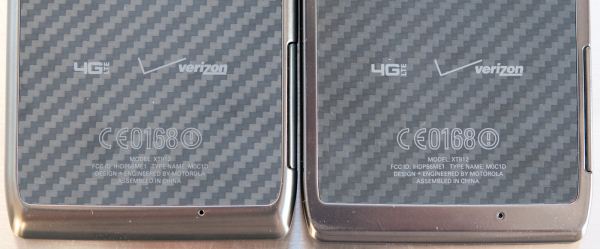Motorola Droid RAZR MAXX Review - 1.8x The Battery
by Brian Klug on February 14, 2012 2:01 PM EST- Posted in
- Smartphones
- Motorola
- Android
- Mobile
- motorola droid RAZR
- RAZR MAXX
- RAZR
Motorola Droid RAZR MAXX Review
For a while now, our chief complaint when talking about 4G LTE handsets has been battery life. The combination of 45nm cellular basebands, ever increasing screen size, and 4x nm SoCs has been unforgiving in the power department. Handset manufacturers are always engaged in a difficult balancing act between device size, price, and the resulting battery life. Too big of a battery and you’ve created a brick that looks unattractive next to other svelte phones, too small and you’ve created something that looks great but needs to be tethered to the wall all day.

Droid RAZR MAXX (left), Droid RAZR (right)
We’ve already reviewed the Motorola Droid RAZR, which itself is a close cousin of the Motorola Droid Bionic. As a result, we’re not going to go into super depth with the MAXX since it would be a 1:1 repeat in basically every part to what we talked about in the RAZR review already. The RAZR MAXX and RAZR are quite literally the exact same device (PCB, display, cellular basebands, camera, etc.) with the exception of battery and exterior case.
The two share the same model number (XT912), FCC-ID (IHDP56ME1), and run the same software. Motorola has talked about reducing the number of devices released yearly and consolidating down to just a few flagships, and though it’s easy to claim otherwise, the RAZR and RAZR MAXX don’t really confuse things that much since, again, they’re really the same phone with a different case and battery. The result of that similarity is that from a software and carrier testing perspective, delivering updates to one means delivering updates to the other, something we’ve already seen turn out to be the case with the recent 6.12.173 update.
What’s changed with the MAXX incantation is its battery, which is significantly larger. It seems as though Motorola has been feeling nostalgic about some of its old brands lately, reviving first the RAZR brand, and now the “MAXX” brand in the form of a moniker (anyone else remember the MOTORAZR MAXX?). In this case, what’s MAXX about the RAZR MAXX is its battery, which is 1.88 times the size of the RAZR battery. (As an aside, I can’t help but think of the Rage Fury MAXX every time I type MAXX)
The MAXX also continues use of Motorola’s higher voltage Li-ion chemistry, which is 3.8V nominal as opposed to the standard 3.7V nominal voltage. Motorola continues to use this higher voltage chemistry on a majority of its new devices. As I talked about in the Bionic and RAZR reviews, this means you can’t directly compare mAh, instead watt-hours is better for comparison purposes here. We’ve been careful about using Whr, and I only think in Whr anymore, which finally paid off with this jump to a higher voltage.
| LTE Smartphone Battery Size Comparison | ||||||
| HTC Rezound | CDMA/LTE Galaxy Nexus | Motorola Droid RAZR | Motorola Droid RAZR MAXX | |||
| Nominal Voltage | 3.7 V | 3.7 V | 3.8 V | 3.8 V | ||
| Capacity in mAh | 1620 mAh | 1800 mAh | 1750 mAh | 3300 mAh | ||
| Capacity in Watt-Hours | 5.99 Whr | 6.66 Whr | 6.65 Whr | 12.54 Whr | ||
Against the competition, the RAZR MAXX battery is positively huge, and is larger than the Bionic’s extended battery which itself was a hefty 10.2 Whr. The battery remains sealed inside and not easily replaceable, but given its size this is a totally acceptable trade-off. That’s really where the MAXX makes sense - if you’re going to sacrifice battery access and replaceability, it should be absolutely beyond a doubt big enough to make it through at least one day’s worth of constant abuse.

RAZR MAXX (bottom), RAZR (top)
The MAXX does put on some weight and get heftier in the midsection as a result, but the phone is still remarkably thin. What’s interesting is that although the RAZR MAXX is thicker than the RAZR at its thinnest point, the two phones’ thickest points are still the same. I guess that really illustrates what’s wrong with the way that OEMs are specifying device “thickness” these days more than anything, as most intentionally cite the device thickness at its thinnest point. One other OEM has told me it’s going to move to a mean thickness measurement, which seems to be more representative but potentially complicated. Personally, giving min and max seems to be the most honest disclosure, and again on the MAXX only the thinnest point gets thicker. Mass goes up 17 grams, just 13% over the RAZR.
| Physical Comparison | ||||
| Apple iPhone 4S | Samsung Galaxy Nexus (LTE) | Motorola Droid RAZR | Motorola Droid RAZR MAXX | |
| Height | 115.2 mm (4.5") | 135.5 mm (5.33") | 130.7 mm (5.15") | 130.7 mm (5.15") |
| Width | 58.6 mm (2.31") | 67.94 mm (2.67) | 68.9 mm (2.71") | 68.9 mm (2.71") |
| Depth | 9.3 mm ( 0.37") | 9.47 mm (0.37") | 7.1 mm (0.28") | 8.99 mm (0.35") |
| Weight | 140 g (4.9 oz) | 150 g (5.3 oz) | 127 g (4.5 oz) | 145 g (5.1 oz) |
| CPU | Apple A5 @ ~800MHz Dual Core Cortex A9 | 1.2 GHz Dual Core Cortex-A9 OMAP 4460 | 1.2 GHz Dual Core Cortex-A9 OMAP 4430 | 1.2 GHz Dual Core Cortex-A9 OMAP 4430 |
| GPU | PowerVR SGX 543MP2 | PowerVR SGX 540 | PowerVR SGX 540 | PowerVR SGX 540 |
| RAM | 512MB LPDDR2-800 | 1 GB LPDDR2 | 1 GB LPDDR2 | 1 GB LPDDR2 |
| NAND | 16GB, 32GB or 64GB integrated | 32 GB NAND | 16 GB NAND, 16 GB microSD class 4 preinstalled | 16 GB NAND, 16 GB microSD class 4 preinstalled |
| Camera | 8 MP with LED Flash + Front Facing Camera | 5 MP with AF/LED Flash, 1080p30 video recording, 1.3 MP front facing | 8 MP with AF/LED Flash, 1080p30 video recording, 1.3 MP front facing | 8 MP with AF/LED Flash, 1080p30 video recording, 1.3 MP front facing |
| Screen | 3.5" 640 x 960 LED backlit LCD | 4.65" 1280x720 SAMOLED HD | 4.3" 960 x 540 SAMOLED Adv. | 4.3" 960 x 540 SAMOLED Adv. |
| Battery | Internal 5.3 Whr | Removable 6.85 Whr | Internal 6.65 Whr | Internal 12.54 Whr |
In the hand, I find the MAXX to unsurprisingly feel very similar to the RAZR. The thickness change is obviously perceptible, but not a big deal. The RAZR remains a thin, flat device, and adding 2 mm at the thinnest point honestly doesn’t change the way that things feel to me. In the pocket, I think you’d have a hard time feeling the difference between the RAZR and the RAZR MAXX - neither print very much in a pair of jeans or dress slacks.
Interestingly enough the most notable change between the RAZR and the RAZR MAXX is that the two don’t lie flat the same way back down on a table. The RAZR tilts slightly thanks to that thickness difference, the RAZR MAXX is very close to being completely coplanar with the surface it’s resting on. The backside still has the slightly rubberized Kevlar material, though the curve at the top isn’t nearly as small. The microSD and microSIM door at the side gets a bit taller as well.
The RAZR MAXX is probably the first time I’ve seen a device offer a significantly larger battery without it being an obvious afterthought. The traditional extended battery upgrade path usually involves getting a new battery door with a huge, obvious, awkward bulge. Almost every single time, that battery door either doesn’t match or fit properly, or it’s just an awkward afterthought. The other upgrade option is usually a battery with the same volume but slightly more capacity. The MAXX is neither - a device with a notably bigger battery that doesn’t make all the concessions that normally accompany such an upgrade.

















45 Comments
View All Comments
jjj - Tuesday, February 14, 2012 - link
Thanks for the charging time test,was curious about that.As for more devices with large battery maybe we'll see more but it's not all about sealing the battery,Moto did a couple of other things like use a thinner screen and populate only 1 side of the PCB.Ofc the touch layers are about to get thinner and Gorilla 2 is also a bit thinner so in theory it is getting easier to fit a larger battery.Problem is that the industry thinks 1 day battery life is the sweetspot and the marketing guys like thinner much better.so chances are that we'll see 6mm phones or less soon but not many will race to include a large battery in a thicker package.There is a next step soon to make em even thinner but,i'll let the phone makers figure that out .
jontech - Tuesday, February 14, 2012 - link
I liked the feel of the RZR but the thickness at the top was simply poor design. Now with a more uniform feel I want to see itmutatio - Tuesday, February 14, 2012 - link
I know, right? I've been sick of the lopsided top end since the designs first came out. I find it a bit ironic that a non-iPhone device went with the built-in battery as that's one of the mantras the Apple haters immediately scream about. This phone sets a high bar for talk time, for sure, though I personally use my cellphone for mostly data related activities.pedro441 - Tuesday, February 14, 2012 - link
So if I'm not worried about computational advantages offered by the new processors and care strictly about battery life on LTE (and recognizing that predicting the future is hard...) which will better get me through the day?shabby - Tuesday, February 14, 2012 - link
My crystal ball says wait for the future to come and then decide.mcnabney - Wednesday, February 15, 2012 - link
At what time in the past 25 years has something bigger, faster, sleeker, smarter, or better NOT just been around the corner?There will be something even COOLER coming out after Krait. There always is. If you need a new device, unless you actually NEED what the next generation has, just buy the device that is best for you now.
pedro441 - Wednesday, February 15, 2012 - link
Yes, I take your point. I will submit, however, that the battery life of successive devices has not been subject to the rapid improvement that those other characteristics you mention have shown.nafhan - Thursday, February 16, 2012 - link
If you're not worried about compute advantages. Get this. I'd guess most phones built on 28nm CPU's will use the lower power draw to allow smaller cheaper batteries not two days of battery life (at least not at first).The Razor MAXX also the obvious advantage of being available NOW instead of some unspecified date in the future. :)
piroroadkill - Tuesday, February 14, 2012 - link
You packed in a massive battery whilst still letting the device remain thin.I sincerely hope every other manufacturer follows suit, fast.
michael2k - Tuesday, February 14, 2012 - link
In both the 3G and 4G tests, we see very close to the expected scaling, and the RAZR MAXX easily captures the top spot.Actually, in the 3G test we show the iPhone 4S has the top spot at 9.85H, so you either have a mistake in text or your graph is wrong.